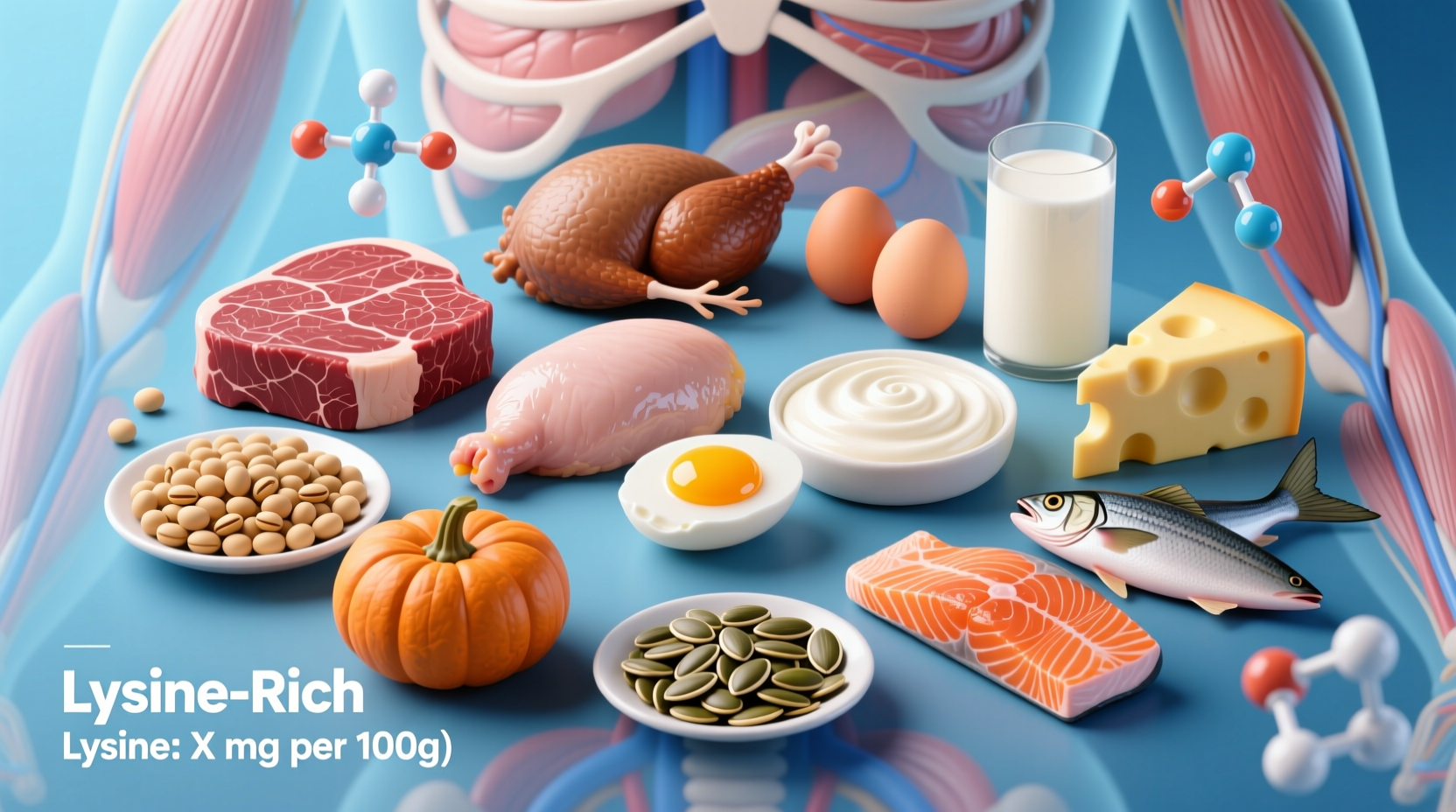Why Lysine Matters for Your Health
Lysine isn't just another amino acid—it's an essential building block your body can't produce on its own. This critical nutrient supports protein synthesis, calcium absorption, immune function, and collagen formation. Without adequate lysine intake, you might experience fatigue, reduced immunity, or even difficulty healing wounds.
Unlike non-essential amino acids, your body has no backup system for lysine. You must get it through your diet daily. The Recommended Dietary Allowance (RDA) for adults is approximately 38 mg per kilogram of body weight, translating to about 2.6 grams daily for a 150-pound person. Athletes, pregnant women, and those recovering from injuries often need significantly more.
Top 15 Lysine-Rich Foods Ranked by Content
Understanding exactly how much lysine you're getting matters. This comprehensive comparison uses verified USDA FoodData Central measurements to show lysine content per standard serving:
| Food | Serving Size | Lysine (mg) | % Daily Value |
|---|---|---|---|
| Beef steak | 3 oz | 1,950 | 85% |
| Chicken breast | 3 oz | 1,860 | 81% |
| Parmesan cheese | 1 oz | 1,260 | 55% |
| Lentils (cooked) | 1 cup | 1,220 | 53% |
| Pumpkin seeds | 1 oz | 780 | 34% |
| Greek yogurt | 1 cup | 750 | 33% |
| Salmon | 3 oz | 1,700 | 74% |
| Eggs | 2 large | 650 | 28% |
| Tempeh | 3 oz | 700 | 30% |
| Quinoa (cooked) | 1 cup | 440 | 19% |
Data source: USDA FoodData Central, Release 2023

When Lysine Intake Becomes Critical
Certain health scenarios dramatically increase your lysine requirements. Understanding these context boundaries helps you adjust your diet appropriately:
- Herpes management: Research from the Mayo Clinic suggests maintaining higher lysine-to-arginine ratios may help reduce outbreak frequency
- Vegan and vegetarian diets: Plant-based eaters need to consciously combine lysine-rich foods since most plants are lower in this amino acid
- Post-surgical recovery: Hospitals often increase protein requirements by 25-50% during healing phases
- Athletic performance: Endurance athletes may require up to 50% more lysine to support muscle repair
Smart Ways to Boost Your Lysine Intake
Simply knowing which foods contain lysine isn't enough—you need practical strategies to incorporate them effectively:
For Meat Eaters
Rotate your protein sources throughout the week. Try a "lysine ladder" approach: start with fish on Monday, poultry on Wednesday, and red meat on Friday. This variety ensures consistent intake while preventing dietary boredom.
For Plant-Based Diets
Combine complementary proteins strategically. Pair legumes with seeds—like lentil soup topped with pumpkin seeds—to create complete protein profiles. Quinoa and amaranth are rare plant exceptions that contain complete proteins including substantial lysine.
Everyday Integration Tips
- Add a scoop of Greek yogurt to smoothies for 750mg lysine boost
- Replace croutons with toasted pumpkin seeds on salads
- Choose tempeh over tofu in stir-fries for 30% more lysine
- Snack on a small handful of pistachios (500mg per ounce)
Common Lysine Myths Debunked
Nutrition misinformation spreads quickly. Let's clarify some persistent lysine misconceptions:
Myth: All animal proteins have equal lysine content
Reality: While most animal proteins are lysine-rich, dairy products vary significantly. Parmesan contains nearly twice as much lysine as cheddar per ounce.
Myth: You need lysine supplements for optimal health
Reality: The National Institutes of Health states that most people meet lysine requirements through diet alone unless they have specific medical conditions (NIH Office of Dietary Supplements).
Historical Understanding of Lysine
Lysine's importance wasn't always understood. This timeline shows key discoveries:
- 1920s: First isolated by German chemist Ferdinand Eder
- 1950s: Recognized as essential for human nutrition
- 1970s: Connection established between lysine deficiency and growth impairment
- 1980s: Research begins on lysine's role in herpes management
- 2000s: USDA begins comprehensive food composition databases tracking amino acid profiles
This evolution in understanding explains why older nutrition resources often overlook lysine-specific recommendations.
Practical Lysine Planning for Your Lifestyle
Your ideal lysine intake depends on your specific circumstances. Use these guidelines to personalize your approach:
- General health maintenance: 30-35 mg per kg body weight daily
- Active individuals: 35-40 mg per kg body weight
- Herpes management: Focus on maintaining lysine-to-arginine ratio above 1:1
- Vegan athletes: Prioritize combining legumes with seeds daily
Track your intake for three days using a food journal. If you consistently fall below 80% of your target, adjust your meal planning with the high-lysine foods listed above.











 浙公网安备
33010002000092号
浙公网安备
33010002000092号 浙B2-20120091-4
浙B2-20120091-4